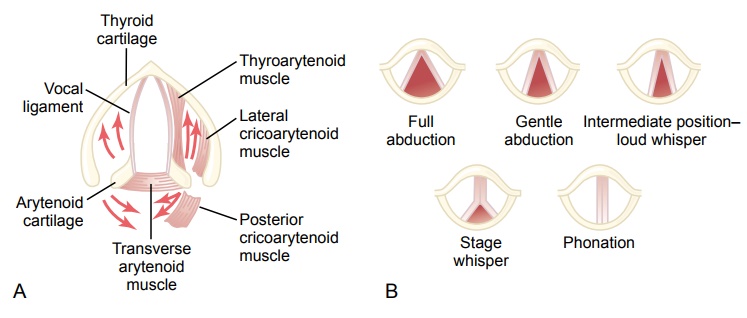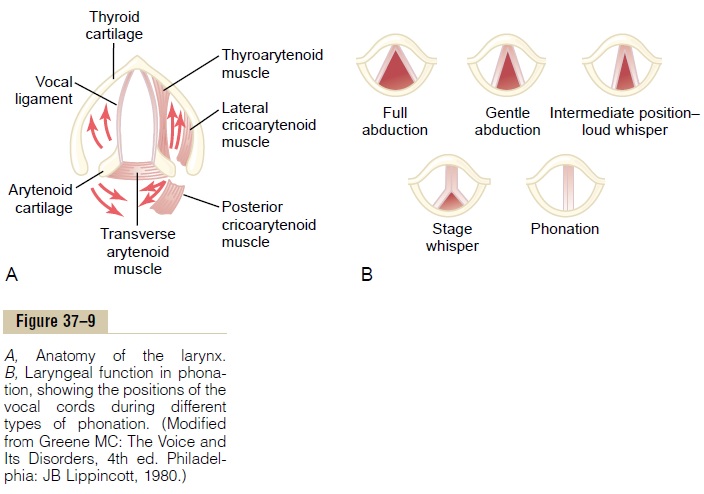Chapter: Medical Physiology: Pulmonary Ventilation
Vocalization - Functions of the Respiratory Passageways

Vocalization
Speech involves not only the respiratory system but also (1) specific speech nervous control centers in the cerebral cortex; (2) respiratory control centers of the brain; and (3) the articulation and resonance structures of the mouth and nasal cavities. Speech is composed of two mechanical functions: (1) phonation, which is achieved by the larynx, and (2) articulation, which is achieved by the structures of the mouth.
Phonation. The larynx, shown in Figure 37–9A, is espe-cially adapted to act as a vibrator. The vibrating element is the vocal folds,commonly called the vocal cords. The vocal cords protrude from the lateral walls of the larynx toward the center of the glottis; they are stretched and positioned by several specific muscles of the larynx itself.
Figure 37–9B shows the vocal cords as they are seen when looking into the glottis with a laryngoscope. During normal breathing, the cords are wide open to allow easy passage of air. During phonation, the cords move together so that passage of air between them will cause vibration. The pitch of the vibration is determined mainly by the degree of stretch of the cords, but also by how tightly the cords are approximated to one another and by the mass of their edges.

Figure 37–9A shows a dissected view of the vocal folds after removal of the mucous epithelial lining. Immediately inside each cord is a strong elastic ligament called the vocal ligament. This is attached anteriorly to the large thyroid cartilage, which is the cartilage that projects forward from the anterior surface of the neck and is called the “Adam’s apple.” Posteriorly, the vocal ligament is attached to the vocal processes of two ary-tenoid cartilages. The thyroid cartilage and the arytenoidcartilages articulate from below with another cartilage not shown in Figure 37–9, the cricoid cartilage.
The vocal cords can be stretched by either forward rotation of the thyroid cartilage or posterior rotation of the arytenoid cartilages, activated by muscles stretching from the thyroid cartilage and arytenoid cartilages to the cricoid cartilage. Muscles located within the vocal cords lateral to the vocal ligaments, the thyroarytenoid muscles, can pull the arytenoid cartilages toward the thyroid cartilage and, therefore, loosen the vocal cords. Also, slips of these muscles within the vocal cords can change the shapes and masses of the vocal cord edges, sharpening them to emit high-pitched sounds and blunt-ing them for the more bass sounds.
Finally, several other sets of small laryngeal muscles lie between the arytenoid cartilages and the cricoid car-tilage and can rotate these cartilages inward or outward or pull their bases together or apart to give the various configurations of the vocal cords shown in Figure 37–9B.
Articulation and Resonance. The three major organs ofarticulation are the lips, tongue, and soft palate. They need not be discussed in detail because we are all famil-iar with their movements during speech and other vocalizations.
The resonators include the mouth, the nose and asso-ciated nasal sinuses, the pharynx, and even the chest cavity. Again, we are all familiar with the resonatingqualities of these structures. For instance, the function of the nasal resonators is demonstrated by the change in voice quality when a person has a severe cold that blocks the air passages to these resonators.
Related Topics